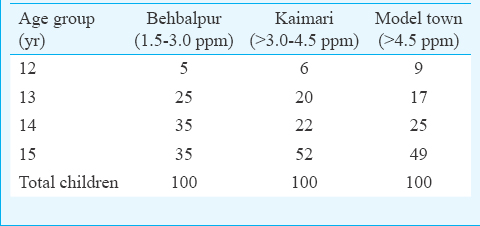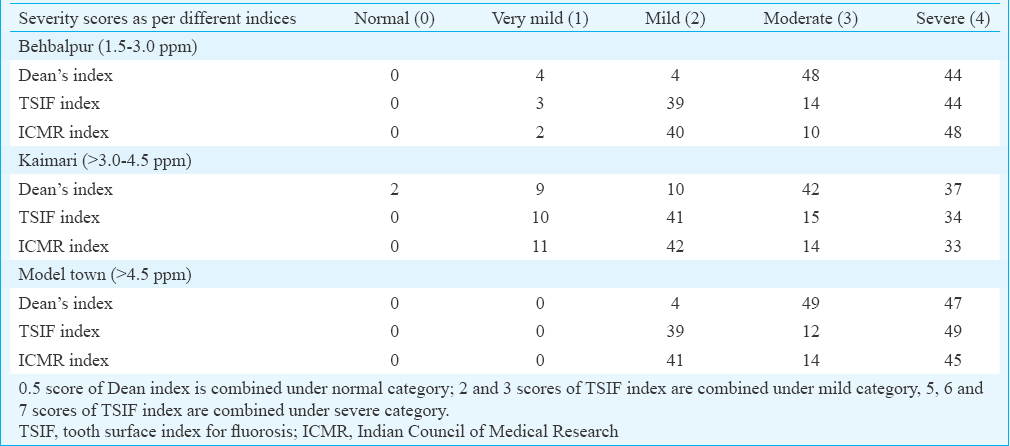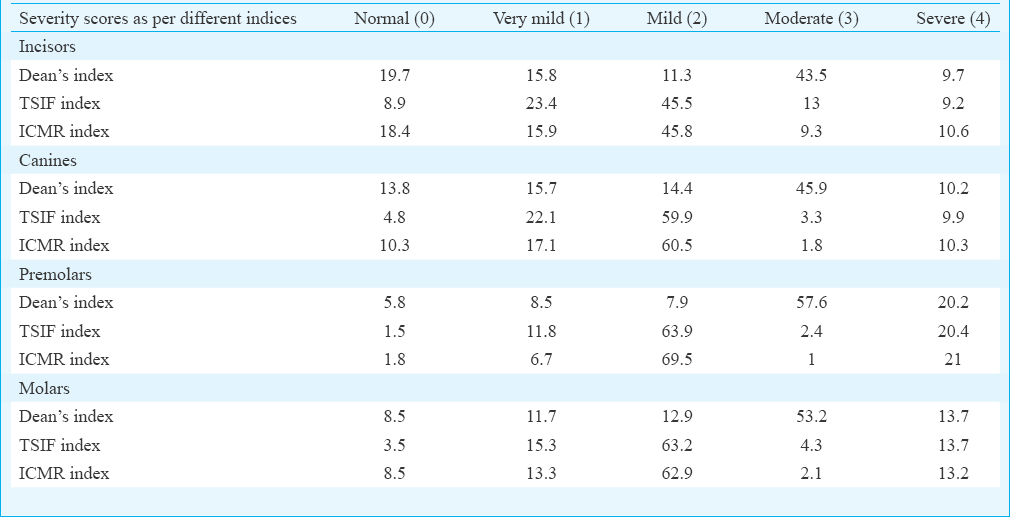Translate this page into:
Comparative evaluation of three different recording criteria of dental fluorosis in a known endemic fluoride area of Haryana
For correspondence: Dr Neeraj Kumar, Unit of Pedodontics & Preventive Dentistry, Oral Health Sciences Centre, Post Graduate Institute of Medical Education and Research, Chandigarh 160 012, India e-mail: dr.neeraj001@gmail.com
-
Received: ,
This is an open access journal, and articles are distributed under the terms of the Creative Commons Attribution-NonCommercial-ShareAlike 4.0 License, which allows others to remix, tweak, and build upon the work non-commercially, as long as appropriate credit is given and the new creations are licensed under the identical terms.
This article was originally published by Medknow Publications & Media Pvt Ltd and was migrated to Scientific Scholar after the change of Publisher.
Abstract
Background & objectives:
Various indices are available to record different grade of severity of dental fluorosis. These indices have chances of inter- and intra- examiner variability. Therefore, study was conducted to compare three different indices for recording dental fluorosis to find out the best and most practical index of recording dental fluorosis for field studies in children living in a fluoride endemic area.
Methods:
The severity grades were recorded in 300 schoolchildren aged 12-15 yr having dental fluorosis of low, medium and high fluoride areas using three different indices, viz. Dean's fluorosis index (1942), tooth surface index for fluorosis (TSIF, 1984) and ICMR index (2013). Dean's index was used as gold standard.
Results:
The occurrence of moderate and severe cases was higher as per the Dean's index and of mild and severe cases was higher as per the TSIF and the ICMR index. The mean time required for recording dental fluorosis as per Dean's index and TSIF was similar and almost double (1.25±0.05 min) of that required for ICMR index (0.68±0.20 min). The intra-examiner variability was found to be least in the ICMR index compared to Dean's index and TSIF.
Interpretation & conclusions:
The ICMR index is a simple index with objective scores and takes less time in recording the dental fluorosis as compared to Dean's index and TSIF in field studies.
Keywords
Dean's fluorosis index
dental fluorosis
ICMR index
intra-examiner reliability
kappa value
tooth surface index for fluorosis
Dental fluorosis is a condition of enamel hypo-mineralization caused due to the effects of excessive fluoride on ameloblasts during enamel formation. Dental fluorosis manifests as an alteration of the normal appearance of enamel ranging from white opacities to dark-brown stains and pitting of enamel surfaces1.
To record the different grades of severity of dental fluorosis, various indices/classification systems have been used. All the indices have detailed criteria for recording, which is time-consuming in epidemiological studies, and chances of inter- and intra-examiner variability are also present. As a further improvement, Indian Council of Medical Research (ICMR) in 2013 has developed an index for dental fluorosis based on modified Dean's criteria (1942)2 with photographic depiction to avoid any variability during recording. Goyal et al3 conducted a pilot study to validate the ICMR index which showed that inter-examiner agreement was almost perfect. The present study was conducted to compare three dental fluorosis indices, viz. Dean's modified index (1942)2, tooth surface index for fluorosis (TSIF, 1984)4 and ICMR criteria for fluorosis (2013)3, for recording dental fluorosis in terms of severity of disease recording and time taken to record dental fluorosis using the different indices in schoolchildren living in an endemic district of Haryana, India.
Material & Methods
The present study was conducted in Oral Health Sciences Centre, at Post Graduate Institute of Medical Education and Research, Chandigarh, India, from January to September 2014. Hisar is one of the endemic districts of Haryana State with high fluoride concentration in groundwater samples5.
Collection and estimation of fluoride levels in the drinking water samples: A total of 23 water samples collected from drinking water sources of Hisar district in the plastic bottles were sent to the International Testing Centre, Panchkula, Haryana, for the estimation of water fluoride levels using zirconium-alizarin method6.
Selection of schools: A list of senior secondary and high schools was obtained from the Directorate of School Education Office, Panchkula, of selected areas with low (1.5-3.0 ppm), medium (3.0-4.5 ppm) and high (>4.5 ppm) fluoride levels in drinking water. Of these, four schools were randomly selected for recording dental fluorosis in children aged 12-15 yr. Official permission was obtained from the concerned authorities to conduct this study.
Sample selection: All the available children of 12-15 yr of age group from selected schools were screened. A total of 600 school children, 12-15 yr of age, having dental fluorosis were screened initially. Of the screened children, at least 100 were selected randomly from each area with dental fluorosis as per Dean's fluorosis index which was used as gold standard. Children with dental fluorosis aged 12-15 yr and permanent residents of the area were preferably included, and children with dental caries/restorations on the buccal and occlusal surfaces of teeth, enamel opacities such as hypoplasia and enamel defects7 were excluded from the study.
Examination of the dental fluorosis using three dental fluorosis indices: Institutional ethical committee clearance was taken before starting the survey. The consent was obtained from the school authorities and the children for visual examination and photography of children. The information regarding demographic data, sources of drinking water, oral hygiene practices and toothpaste used (fluoridated or non-fluoridated) was recorded using a questionnaire. Photographic records were made of each patient recorded for dental fluorosis. Photographs were taken using a digital single lens reflex camera (Nikon D-3200, Japan) with micro-lens and ring flash under natural light. The examination was performed in the schools during school hours with the child sitting on an ordinary chair under adequate daylight using a mouth mirror and an explorer. During recording in the field area, the labial and buccal surfaces of all teeth present were examined for dental fluorosis. The interval between the evaluations using a different index was kept as one month to ensure a complete wash out of the dental fluorosis scores of the children from the mind of the investigator who was making the recordings. A gap interval of one week in recording of dental fluorosis using three indices was given by Pereira and Moreira8 in their study conducted in three cities with different water fluoride concentration.
Statistical analysis: The data was recorded on a specially prepared proforma and descriptive data was analyzed by percentage, mean and standard deviation. Comparison of fluorosis data collected using the three different dental fluorosis indices was done by using Chi-square test using SPSS version 15.0 for Windows (SPSS Inc., Chicago, IL, USA). Statistical correlations between the recordings as per indices used were calculated using descriptive statistical analysis test. Kappa statistics value was used for calculating intra-examiner agreement of the examiner. All statistical tests were two-sided and performed at a significance level of α=.05.
Results
A total of 300 schoolchildren aged 12-15 yr were evaluated in the present study (Table I). Drinking water fluoride levels of Hisar district were measured initially and divided into three areas with different fluoride levels. One hundred schoolchildren from each area were selected from the schools. Ninety six per cent of schoolchildren were permanent residents of Hisar, and 78 per cent of the children brushed their teeth with fluoridated toothpaste in all the three selected areas. Ninety nine per cent of the children had no knowledge regarding aetiology of dental fluorosis.

The severity of dental fluorosis evaluated as per Dean's index in the selected children was similar in the three areas, i.e. moderate and severe grades. As per the ICMR index and TSIF, scores of mild and severe categories were higher compared to very mild and moderate categories (Table II).

On comparative evaluation of severity of dental fluorosis, the overall agreement between the Dean's index and TSIF was found to be average (κ=0.31); between Dean's index and ICMR index, the overall agreement was slight (κ=0.181) and between the TSIF and ICMR index, the overall agreement was moderate (κ=0.597).
As per Dean's index, in the moderate and severe categories, the teeth affected were in the order premolars > molars > canines > incisors, whereas in the very mild and mild categories, the order was canines > incisors > molars > premolars. As per TSIF and ICMR index, in the mild and severe categories, the teeth affected were in the order premolars > molars > canines > incisors, whereas in the very mild categories, the order was canines > incisors > molars > premolars. In the moderate category, incisors were the most commonly affected (TSIF=13% and ICMR=9.3%) (Table III).

The mean time required for recording dental fluorosis severity as per Dean's index and TSIF was similar and almost double (1.25±0.05 min) of that required for ICMR index (0.68±0.20 min) (P=0.04). The intra-examiner variability with all the three indices was found to be the least, with good agreement between scores, as evaluated on 10 per cent of the sample at different time intervals, with a kappa value of 0.866, 0.951 and 0.994 for the Dean's, TSIF and ICMR indices, respectively.
Discussion
The present study was conducted in Hisar district of Haryana as it represents an area of endemic fluorosis with water fluoride levels ranging between 0.03 and 16.3 ppm5.First eight years of life is a critical period during which excessive amount of fluoride in the water may affect the mineralization of the teeth and cause dental fluorosis9. Most of the children in three areas used fluoridated toothpaste for brushing. The severity of dental fluorosis has been found to be associated with dental caries1011. As fluoride dentifrices exert a significant topical effect on enamel and prevent it from dental caries by forming a reservoir in the dental plaque, it is able to halt the disintegration of the already demineralized/fluorosed enamel1213.
The severity of dental fluorosis evaluated as per Dean's index in selected children aged 12-15 yr was similar in the three areas. This could be possible because the low fluoride level of Behbalpur was also sufficient to cause moderate-to-severe levels of dental fluorosis. These results were similar to those reported earlier by others1415 who reported that an increase in fluoride in drinking water showed a corresponding increase in severity of dental fluorosis according to Dean's index. Photographs were used to record the severity of the dental fluorosis for the ICMR index. Photographic assessment facilitates randomization and blinding and provides objective scores rather than clinical method. On the other hand, disadvantages of photography are cost and technical sensitivity and require more than one surface photograph161718.
On comparison of the results according to the three indices, those cases which were categorized as moderate fluorosis according to Dean's index got distributed into mild (white opacities alone) and moderate category (brown stains also present) by TSIF index and ICMR index. As per TSIF and ICMR index, there is a clear distinction between teeth with white opacities (mild fluorosis) and brown stains (moderate fluorosis). This distinction represents the benefit of using TSIF or ICMR index in epidemiological studies or surveys of dental fluorosis in contrast to Dean's index which may overestimate the severity of fluorosis, especially with regard to the moderate category.
In the present study, the incisors and canines in the two arches were found to be less affected compared to the premolars and second molars. The possible reason behind this could be the calcification schedule of the teeth. The incisors and canines start calcifying at an early age of 4-5 months compared to premolars and second molars (18-36 months of age)19. These are thus affected by only mild and very mild type of dental fluorosis compared to the premolars and second molars which are exposed to high doses of fluoride right from the early stages of maturation and get affected by more severe type of fluorosis. Pereira and Moreira8 found a similar trend of severity of dental fluorosis in different teeth as shown in the present study with premolars and molars being the most severely affected.
The intra-examiner variability with all the three indices was found to be the least, with good agreement between scores with a kappa value of 0.866, 0.951 and 0.994 for the Dean's, TSIF and ICMR indices, respectively. In a study by Goyal et al3 the kappa value was found to be 0.59-1.0 on the evaluation of photographs using ICMR criteria (2013). Soto-Rojas et al20 also found a 100 per cent agreement on repeat (10% of cases) examination of the photographs using the TSIF. Other studies also showed good reproducibility among examiners (kappa value of 0.87 and 0.64) on photographic evaluation2122. The small sample size was the major limitation of the study. Future studies need to be conducted in different geographical areas with a larger sample size to make a conclusive statement.
The ICMR index is a simple index with objective scores and takes less time in recording the dental fluorosis. Dean's index is not an accurate criterion for the assessment of severity of dental fluorosis in areas with water fluoride levels higher than 3.0 ppm. In such areas, alternative indices such as TSIF and ICMR index may be used to differentiate the different grades of dental fluorosis more objectively. However, TSIF index (1984) is a clinical index with more detailed criteria not suitable for the field trials. ICMR index measures the actual severity of dental fluorosis compared to Dean's index which overestimates the severity of dental fluorosis.
Acknowledgment
The Authors thank the principals of all the participating schools for their help. Authors also thank the International Testing Centre, Panchkula, Haryana for their support in sample testing.
Financial support & sponsorship: None.
Conflicts of Interest: None.
References
- Impact of anti-oxidative therapy on the activity of salivary glutathione-dependent enzymes in patients with fluorosis. Clin Lab Diag. 2007;22:35-7.
- [Google Scholar]
- The investigation of physiologic effects by epidemiological method In: Moulton FR, editor Fluorine and dental health. Washington, DC: American Association for the Advancement of Science; 1942. p. :23-31.
- [Google Scholar]
- Validation of ICMR index for identification of dental fluorosis in epidemiological studies. Indian J Med Res. 2016;144:52-7.
- [Google Scholar]
- A new method for assessing the prevalence of dental fluorosis - The tooth surface index of fluorosis. J Am Dent Assoc. 1984;109:37-41.
- [Google Scholar]
- Hydro-chemical survey of groundwater of Hisar city and assessment of defluoridation methods used in India. Environ Monit Assess. 2007;132:33-43.
- [Google Scholar]
- Determination of fluoride in water. A modified Zirconium-Alizarin method. Ind Eng Chem Anal Ed. 1945;17:148-9.
- [Google Scholar]
- The differential diagnosis of fluoride and nonfluoride opacities. J Public Health Dent. 1961;21:143-6.
- [Google Scholar]
- Analysis of three dental fluorosis indexes used in epidemiologic trials. Braz Dent J. 1999;10:29-37.
- [Google Scholar]
- Groundwater quality in some villages of Haryana, India: Focus on fluoride and fluorosis. J Hazard Mater. 2004;106:55-60.
- [Google Scholar]
- The relationship between dental caries and dental fluorosis in areas with moderate- and high-fluoride drinking water in Ethiopia. Community Dent Oral Epidemiol. 2004;32:337-44.
- [Google Scholar]
- Dental caries and developmental defects of enamel in relation to fluoride levels in drinking water in an arid area of Sri Lanka. Caries Res. 2002;36:398-404.
- [Google Scholar]
- Fluoride supplement use by children in fluoridated communities. J Public Health Dent. 1995;55:160-4.
- [Google Scholar]
- Dental fluorosis and caries prevalence in the fluorosis endemic area of Asembagus, Indonesia. Int J Paediatr Dent. 2002;12:415-22.
- [Google Scholar]
- Prevalence of dental fluorosis in rural areas of Davangere, India. Int Dent J. 2004;54:235-9.
- [Google Scholar]
- A standardized photographic method for evaluating enamel opacities including fluorosis. Community Dent Oral Epidemiol. 2004;32(Suppl 1):19-27.
- [Google Scholar]
- Agreement amongst examiners assessing dental fluorosis from digital photographs using the TF index. Community Dent Health. 2007;24:21-5.
- [Google Scholar]
- A photographic study of developmental defects of enamel in Brazilian school children. Int Dent J. 1996;46:69-75.
- [Google Scholar]
- Development of the human jaws and surrounding structures from birth to age fifteen. J Am Dent Assoc. 1933;20:379.
- [Google Scholar]
- Development of a standardisation device for photographic assessment of dental fluorosis in field studies. Oral Health Prev Dent. 2008;6:29-36.
- [Google Scholar]
- Investigation of the value of a photographic tool to measure self-perception of enamel opacities. BMC Oral Health. 2012;12:41.
- [Google Scholar]
- Examiner reliability of fluorosis scoring: A comparison of photographic and clinical examination findings. J Public Health Dent. 2012;72:172-5.
- [Google Scholar]






